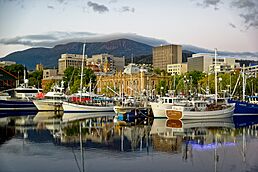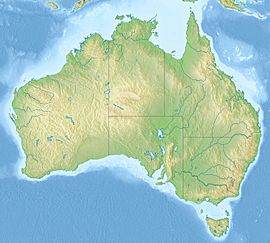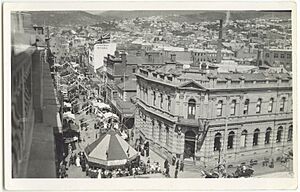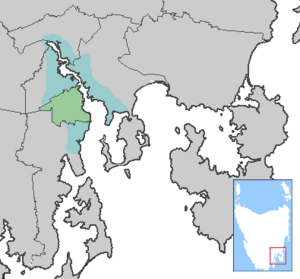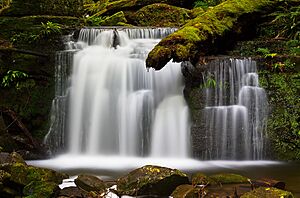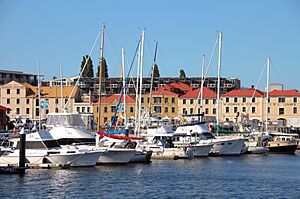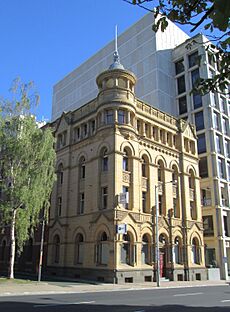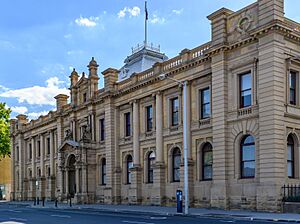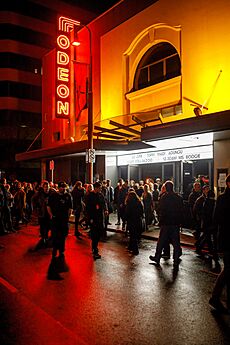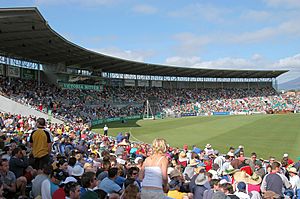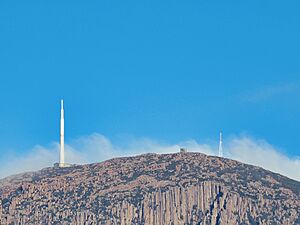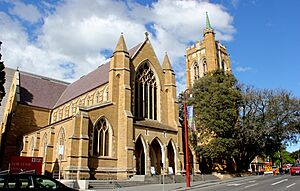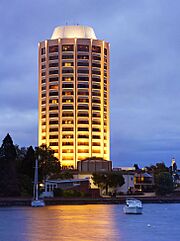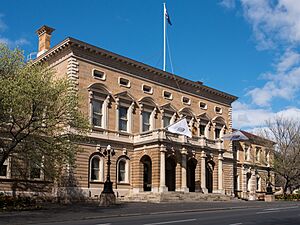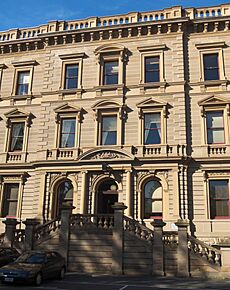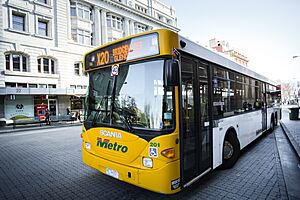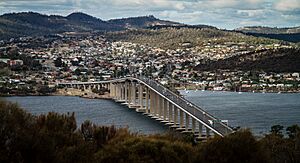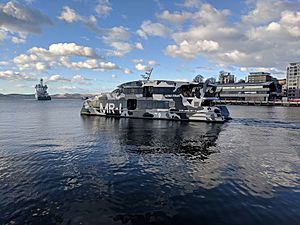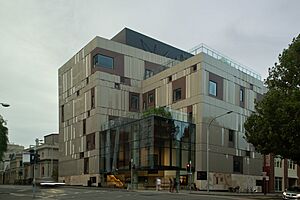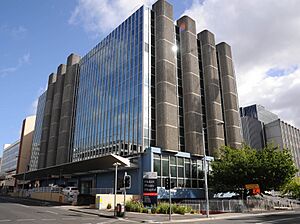Hobart facts for kids
Quick facts for kids HobartTasmania |
|||||||||
|---|---|---|---|---|---|---|---|---|---|
|
Hobart City Centre and Mount Wellington
Museum of Old and New Art
|
|||||||||
| Population |
|
||||||||
| • Density | 145.7/km2 (377/sq mi) (2021) | ||||||||
| Established | 20 February 1804 | ||||||||
| Elevation | 17 m (56 ft) | ||||||||
| Area | 1,758.8 km2 (679.1 sq mi) (metropolitan) | ||||||||
| Time zone | AEST (UTC+10) | ||||||||
| • Summer (DST) | AEDT State: Tasmania. (UTC+11) | ||||||||
| Location |
|
||||||||
| LGA(s) |
|
||||||||
| State electorate(s) | |||||||||
| Federal Division(s) | |||||||||
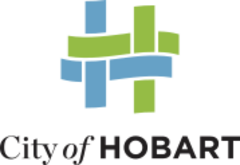 |
|||||||||
| Website | Hobart | ||||||||
|
|||||||||
Hobart is the capital city of Tasmania, an island state in Australia. It is located in Tasmania's south-east, right on the River Derwent. This makes it the southernmost capital city in Australia.
Even though nearly half of Tasmania's people live here, Hobart is the smallest Australian state capital by population. Its skyline is famous for the tall kunanyi / Mount Wellington, which is 1,271 metres (4,170 ft) high. Hobart's harbour is also one of the deepest natural ports in the world. The larger area around the city is called Greater Hobart.
Before British settlers arrived, the local Muwinina people called this land Nipaluna. Aboriginal Tasmanians, also known as Palawa or Pakana, lived here for possibly 35,000 years.
Hobart was started in 1804 as a British penal colony, a place where convicts were sent. This makes it Australia's second-oldest capital city after Sydney. Whaling (hunting whales) became a big industry. For a while, Hobart was the main whaling port in the Southern Ocean.
After convict transportation stopped in the 1850s, the city grew and changed. The early 1900s brought a boost from mining and farming. Even with people leaving for the world wars, new immigrants helped the population grow. Today, Hobart is a major centre for money and government in Tasmania. It's also a popular place for tourists. People love its old buildings, the Salamanca Market, and the Museum of Old and New Art (MONA).
Contents
City's Name
In 1804, the settlement was first called Hobart Town or Hobarton. It was named by Lieutenant-Governor David Collins after Lord Hobart. The city's name was shortened to Hobart in 1881. People who live there are called Hobartians.
The local Aboriginal people had their own name for the area: Nipaluna. This name was recorded in 1831. Other Aboriginal names for different parts of the area were also known. For example, the river was called timtumili minanya.
Hobart's Past
The first European settlement in the area began in 1803. It was a military camp at Risdon Cove on the eastern side of the River Derwent. The British were worried about French explorers in the area. Later in 1804, Captain David Collins moved the camp to a better spot, which is where Hobart is today.
The original people living here were the Mouheneener tribe. Sadly, many Aboriginal people were affected by conflicts and diseases brought by the European settlers. In 1832, some Aboriginal leaders tried to make peace with the Governor. However, they were later forced to move to Flinders Island.
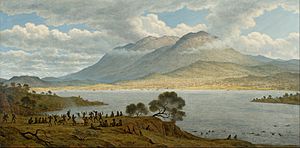
Charles Darwin visited Hobart in 1836 on the HMS Beagle ship. He wrote about how beautiful the area was. He noted that Hobart had 13,826 people in 1835.
The River Derwent was a great deepwater port. It became a hub for whaling and sealing. Hobart Town officially became a city on August 21, 1842. It was renamed Hobart in 1881.
The city had ups and downs economically. But it also grew closer to mainland Australia and saw more tourism in the 1880s. Important places like The University of Tasmania were also started. Mark Twain visited in 1895 and called Hobart "the neatest town that the sun shines on."
On September 7, 1936, the last known thylacine (Tasmanian tiger) died at the Beaumaris Zoo in Hobart. During WW2, the city prepared for attacks. German mines were found in the river, and a Japanese plane flew over in 1942.
In the mid-1900s, Hobart worked to become a tourist spot. Australia's first legal casino, Wrest Point Hotel Casino, opened in 1973. However, Hobart also faced big challenges. The 1967 Tasmanian fires caused a lot of damage and loss of life. In 1975, the Tasman Bridge disaster happened when a ship hit the bridge, breaking it and cutting off the eastern suburbs.
In the 2000s, Hobart's economy improved. The city's population started growing again. Many new projects have been built, like the redevelopment of Macquarie Point.
City's Layout
Land and Features
Hobart is built on the River Derwent estuary in the south-east of Tasmania. It sits mostly on hills made of a rock called dolerite. The city stretches along both sides of the river.
The western side goes from the Derwent Valley to flatter areas around Glenorchy. It's surrounded by peaks like kunanyi / Mount Wellington. The eastern side spreads out from the river, with hills like the Meehan Range.
Hobart has many beaches along the Derwent estuary. These include Long Beach, Nutgrove Beach, and Bellerive Beach. There are also more beaches in Frederick Henry Bay, like Seven Mile Beach.

Plants and Animals
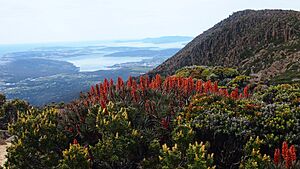
Hobart is surrounded by beautiful native bushland. This includes Wellington Park on kunanyi / Mt Wellington. This area is home to many Tasmanian birds. Rare plants like the Risdon peppermint grow here. Common trees include blue gum and blue wattle.
Animals like the swift parrot, eastern barred bandicoot, and eastern quoll are found in Hobart. You might often see pademelons and wallabies. Platypuses live in the Hobart Rivulet.
Some parts of kunanyi / Mt Wellington have very old white gums and giant stringybarks. There's even a rare patch of Tasmanian rainforest near Collinsvale.
Weather and Climate
Hobart has a cool to mild oceanic climate. This means it has cool summers and mild winters. The highest temperature ever recorded was 41.8 °C (107.2 °F) on January 4, 2013. The lowest was −2.8 °C (27.0 °F) in 1972 and 1981.
Hobart gets about 5.9 hours of sunshine per day. In summer, it has the most daylight hours of any Australian city, with 15.3 hours on the longest day.
Light frost happens most years. Snow is rare in the city centre itself. But kunanyi / Mount Wellington often has snow on its peak throughout the year. Outer suburbs higher up the mountain get snow more often.
| Month | Jan | Feb | Mar | Apr | May | Jun | Jul | Aug | Sep | Oct | Nov | Dec | Year |
|---|---|---|---|---|---|---|---|---|---|---|---|---|---|
| Record high °C (°F) | 41.8 (107.2) |
40.1 (104.2) |
39.1 (102.4) |
31.0 (87.8) |
25.7 (78.3) |
20.6 (69.1) |
22.1 (71.8) |
24.5 (76.1) |
31.0 (87.8) |
34.6 (94.3) |
36.8 (98.2) |
40.6 (105.1) |
41.8 (107.2) |
| Mean daily maximum °C (°F) | 22.7 (72.9) |
22.2 (72.0) |
20.7 (69.3) |
17.9 (64.2) |
15.3 (59.5) |
12.7 (54.9) |
12.6 (54.7) |
13.7 (56.7) |
15.7 (60.3) |
17.6 (63.7) |
19.1 (66.4) |
21.0 (69.8) |
17.6 (63.7) |
| Daily mean °C (°F) | 17.9 (64.2) |
17.5 (63.5) |
16.2 (61.2) |
13.7 (56.7) |
11.5 (52.7) |
9.1 (48.4) |
8.9 (48.0) |
9.7 (49.5) |
11.3 (52.3) |
13.0 (55.4) |
14.6 (58.3) |
16.3 (61.3) |
13.3 (55.9) |
| Mean daily minimum °C (°F) | 13.0 (55.4) |
12.8 (55.0) |
11.6 (52.9) |
9.4 (48.9) |
7.6 (45.7) |
5.5 (41.9) |
5.2 (41.4) |
5.6 (42.1) |
6.9 (44.4) |
8.3 (46.9) |
10.0 (50.0) |
11.6 (52.9) |
9.0 (48.2) |
| Record low °C (°F) | 3.3 (37.9) |
3.4 (38.1) |
1.8 (35.2) |
0.7 (33.3) |
−1.6 (29.1) |
−2.8 (27.0) |
−2.8 (27.0) |
−1.8 (28.8) |
−0.8 (30.6) |
0.0 (32.0) |
0.3 (32.5) |
3.3 (37.9) |
−2.8 (27.0) |
| Average rainfall mm (inches) | 43.7 (1.72) |
37.8 (1.49) |
37.0 (1.46) |
42.6 (1.68) |
39.2 (1.54) |
46.0 (1.81) |
44.5 (1.75) |
63.0 (2.48) |
55.6 (2.19) |
52.8 (2.08) |
50.7 (2.00) |
53.0 (2.09) |
565.9 (22.28) |
| Average precipitation days (≥ 0.2 mm) | 9.5 | 9.1 | 11.3 | 11.1 | 12.0 | 12.4 | 14.1 | 15.3 | 15.7 | 15.0 | 13.5 | 11.7 | 150.7 |
| Average rainy days (≥ 1 mm) | 5.5 | 5.2 | 6.7 | 7.2 | 6.5 | 7.2 | 8.4 | 9.9 | 9.7 | 9.2 | 8.1 | 7.4 | 91.0 |
| Average afternoon relative humidity (%) | 51 | 52 | 52 | 56 | 58 | 64 | 61 | 56 | 53 | 51 | 53 | 49 | 55 |
| Mean monthly sunshine hours | 257.3 | 226.0 | 210.8 | 177.0 | 148.8 | 132.0 | 151.9 | 179.8 | 195.0 | 232.5 | 234.0 | 248.0 | 2,393.1 |
| Percent possible sunshine | 59 | 62 | 57 | 59 | 53 | 49 | 53 | 58 | 59 | 58 | 56 | 53 | 56 |
| Source 1: Bureau of Meteorology (1991–2020 averages; extremes 1882–present) | |||||||||||||
| Source 2: Bureau of Meteorology, Hobart Airport (sunshine hours) | |||||||||||||
| Climate data for Hobart Airport (Cambridge) 1991–2020 averages, 1958–2022 extremes | |||||||||||||
|---|---|---|---|---|---|---|---|---|---|---|---|---|---|
| Month | Jan | Feb | Mar | Apr | May | Jun | Jul | Aug | Sep | Oct | Nov | Dec | Year |
| Record high °C (°F) | 41.4 (106.5) |
39.8 (103.6) |
38.1 (100.6) |
31.8 (89.2) |
25.6 (78.1) |
19.6 (67.3) |
20.4 (68.7) |
23.7 (74.7) |
31.1 (88.0) |
33.4 (92.1) |
38.5 (101.3) |
40.8 (105.4) |
41.4 (106.5) |
| Mean maximum °C (°F) | 35.2 (95.4) |
33.3 (91.9) |
31.2 (88.2) |
25.5 (77.9) |
21.5 (70.7) |
17.6 (63.7) |
16.8 (62.2) |
19.4 (66.9) |
22.4 (72.3) |
27.0 (80.6) |
30.2 (86.4) |
32.2 (90.0) |
36.9 (98.4) |
| Mean daily maximum °C (°F) | 23.1 (73.6) |
22.5 (72.5) |
21.1 (70.0) |
18.2 (64.8) |
15.6 (60.1) |
13.2 (55.8) |
13.0 (55.4) |
13.9 (57.0) |
15.7 (60.3) |
17.7 (63.9) |
19.5 (67.1) |
21.4 (70.5) |
17.9 (64.2) |
| Daily mean °C (°F) | 17.9 (64.2) |
17.5 (63.5) |
16.1 (61.0) |
13.5 (56.3) |
11.3 (52.3) |
9.1 (48.4) |
8.7 (47.7) |
9.5 (49.1) |
11.1 (52.0) |
12.8 (55.0) |
14.6 (58.3) |
16.3 (61.3) |
13.2 (55.8) |
| Mean daily minimum °C (°F) | 12.6 (54.7) |
12.4 (54.3) |
11.0 (51.8) |
8.8 (47.8) |
6.9 (44.4) |
4.9 (40.8) |
4.4 (39.9) |
5.0 (41.0) |
6.4 (43.5) |
7.9 (46.2) |
9.7 (49.5) |
11.2 (52.2) |
8.4 (47.1) |
| Mean minimum °C (°F) | 7.1 (44.8) |
7.0 (44.6) |
5.6 (42.1) |
3.3 (37.9) |
1.9 (35.4) |
0.1 (32.2) |
0.2 (32.4) |
0.5 (32.9) |
1.4 (34.5) |
2.6 (36.7) |
4.3 (39.7) |
5.8 (42.4) |
−0.4 (31.3) |
| Record low °C (°F) | 3.7 (38.7) |
3.4 (38.1) |
2.2 (36.0) |
−0.6 (30.9) |
−2.2 (28.0) |
−3.9 (25.0) |
−3.2 (26.2) |
−2.0 (28.4) |
−2.3 (27.9) |
−1.0 (30.2) |
1.7 (35.1) |
2.7 (36.9) |
−3.9 (25.0) |
| Average rainfall mm (inches) | 40.7 (1.60) |
35.2 (1.39) |
34.1 (1.34) |
35.6 (1.40) |
30.4 (1.20) |
38.9 (1.53) |
33.8 (1.33) |
46.0 (1.81) |
39.8 (1.57) |
40.2 (1.58) |
42.2 (1.66) |
46.6 (1.83) |
463.5 (18.25) |
| Average rainy days (≥ 0.2 mm) | 9.0 | 8.8 | 10.3 | 10.1 | 10.3 | 11.4 | 13.0 | 13.6 | 13.9 | 13.3 | 12.4 | 11.3 | 137.4 |
| Average afternoon relative humidity (%) | 49 | 51 | 50 | 54 | 57 | 62 | 60 | 55 | 52 | 50 | 50 | 47 | 53 |
| Source: Bureau of Meteorology | |||||||||||||
| Climate data for Hobart | |||||||||||||
|---|---|---|---|---|---|---|---|---|---|---|---|---|---|
| Month | Jan | Feb | Mar | Apr | May | Jun | Jul | Aug | Sep | Oct | Nov | Dec | Year |
| Average sea temperature °C (°F) | 16.9 (62.4) |
16.4 (61.5) |
16.4 (61.5) |
15.4 (59.7) |
14.6 (58.3) |
13.6 (56.5) |
12.9 (55.2) |
12.7 (54.9) |
12.7 (54.9) |
13.1 (55.6) |
14.4 (57.9) |
15.9 (60.6) |
14.6 (58.3) |
| Mean daily daylight hours | 15.0 | 14.0 | 12.0 | 11.0 | 10.0 | 9.0 | 9.0 | 10.0 | 12.0 | 13.0 | 15.0 | 15.0 | 12.1 |
| Average Ultraviolet index | 11 | 9 | 6 | 4 | 2 | 1 | 1 | 2 | 4 | 6 | 8 | 10 | 5.3 |
| Source: Weather Atlas, seatemperature.org | |||||||||||||
City Life and Design
Parks and Green Spaces
Hobart has many natural areas, parks, and gardens. The most famous is Wellington Park, which covers kunanyi / Mt Wellington. This park has many trails for walking, hiking, and mountain biking. Some trails follow rivers like the Hobart Linear Park.

The city also has urban bushland areas. The Queens Domain is a large park in the city centre. It includes the Royal Tasmanian Botanical Gardens, which opened in 1818. This is a very popular place to visit. Other parks include St David's Park and Franklin Square.
Buildings and Styles
Hobart's buildings show different styles from Australian history. The city is known for its well-kept Georgian and Victorian-era buildings. These give some areas an "old world" feel.
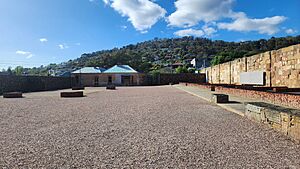
Many of the city's oldest buildings are in the centre. The Hope and Anchor Tavern (1807) and Ingle Hall (1811–14) are examples. The Cascade Brewery (1824) was built by convicts and is Australia's longest-running brewery. The Cascades Female Factory (1828) is another important historic site.
Other famous old buildings include Hadley's Orient Hotel (1834), Australia's oldest hotel. The Theatre Royal (1837) is Australia's oldest theatre still in use. The Lady Franklin Gallery (1843) was Australia's first private museum. The Hobart Synagogue (1845) is Australia's oldest synagogue. Salamanca Place has many Georgian buildings.
The Hobart Town Hall was opened in 1866. St David's Cathedral, Hobart's first cathedral, was finished in 1874. The GPO was built in 1905. Hobart also has many Art Deco buildings from the 1930s.
The Wrest Point Casino (1973) is the tallest building in Tasmania. Newer buildings include the Hotel Grand Chancellor (1987). The Royal Hobart Hospital had a big redevelopment in 2020.
Homes and Living
Hobart's housing has changed over time. Early homes were small and close together. As the city grew, public transport like trams helped people live further out. Inner suburbs from this time have neat streets with timber and brick cottages.
After World War II, many bungalows were built. Today, Hobart is the least dense Australian capital. Housing costs are high, which can be a challenge for people living there.
Arts and Fun
Since the 2000s, Hobart has become known as a "cool" and creative city. Many tourists come for its unique events and art. The Museum of Old and New Art (MONA) has had a big impact on tourism.
The city's nightlife is mainly in Salamanca Place, North Hobart, and the waterfront. These areas have popular restaurants, pubs, and clubs.
Shows and Entertainment

Hobart has several theatres. The Theatre Royal, opened in 1837, is Australia's oldest theatre that is still used. The Playhouse Theatre is another historic venue.
The State Cinema in North Hobart is a large art-house cinema. It started as the North Hobart Picture Palace in 1913.
Art and History Places
Australia's first private museum, the Lady Franklin Gallery, opened in 1843. The Tasmanian Museum and Art Gallery (TMAG) was founded in 1846. It has grown to include several historic buildings. The Maritime Museum Tasmania is also on the waterfront.
The Museum of Old and New Art (MONA) opened in 2011. It is the Southern Hemisphere's largest privately owned museum. It holds the art collection of David Walsh.
Books and Stories
The first general Australian book was published in Hobart. It was about a bushranger named Michael Howe. In 1824, Andrew Bent started Australia's first free press in Hobart. The first Australian novel, Quintus Servinton, was also written and published in Hobart in 1831.
The State Library of Tasmania is in the city centre. It has a large collection of old works. In 2023, Hobart became a UNESCO City of Literature.
Music Scene
The Tasmanian Symphony Orchestra performs at the Federation Concert Hall. Other places for live music include the Odeon Theatre and Hobart City Hall. Big music events are often held at MyState Bank Arena.
Many famous musicians have come from Hobart. These include bands like Striborg and Psycroptic. Brian Ritchie from the band Violent Femmes now lives in Hobart.
Festivals and Events
Hobart has many regular events. The most famous is the weekly Salamanca Market. The city also hosts festivals like Taste of Tasmania, which celebrates local food and wine. Dark Mofo is a big winter festival with art and music.
The Australian Wooden Boat Festival happens every two years. It takes place at the same time as the Royal Hobart Regatta, Tasmania's oldest sporting event. The Hobart Show Day in October celebrates agriculture.
The Hobart International is an annual tennis tournament. Hobart is also the finish line for the Targa Tasmania rally car event.
Sports in Hobart
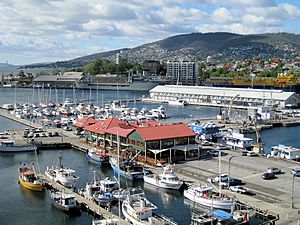
Cricket is very popular in Hobart. The Tasmanian Tigers play their home games at Bellerive Oval. The Hobart Hurricanes also play there in the Big Bash League.
Australian rules football is the most popular spectator sport. Hobart has four local clubs in the Tasmanian Football League. In 2023, Tasmania was given a chance to have its own Australian Football League (AFL) team, the Tasmanian Devils. This depends on a new stadium being built at Macquarie Point.
Hobart is famous in the yachting world as the end point of the Sydney to Hobart Yacht Race. This race starts in Sydney on Boxing Day. The arrival of the yachts is part of the Hobart Summer Festival.
The Tasmania JackJumpers joined the National Basketball League in 2021.
| Club | League | Sport | Venue | Established |
|---|---|---|---|---|
| Tasmania Football Club | AFL/AFLW/VFL/VFLW | Australian rules football | Ninja Stadium/Macquarie Point Stadium/Kingston Twin Ovals | 2023 |
| Tasmania JackJumpers | NBL | Basketball | MyState Bank Arena | 2020 |
| Hobart Hurricanes | BBL | Cricket | Ninja Stadium | 2011 |
| Hobart Hurricanes Women | WBBL | Cricket | Ninja Stadium | 2015 |
| Tasmania Men | Sheffield Shield | Cricket | Ninja Stadium | 1851 |
| Tasmania Women | WNCL | Cricket | Ninja Stadium | 1906 |
| Hobart Chargers | NBL1 South | Basketball | Hobart Netball and Sports Centre/South East Stadium | 1981 |
| Tasmania Rugby Union Team | National Rugby Championship | Rugby Union | Rugby Park | 1949 |
| Tasmania Rugby League Team | Affiliated States Championship | Rugby League | North Hobart Oval | 1953 |
| Tasmania Wild | Australian Netball Championships | Netball | Hobart Netball and Sports Centre | 2022 |
| Tassie Tigers | Hockey One | Field hockey | Tasmanian Hockey Centre | 2019 |
| Tasmania Devils Academy | Talent League Boy/Talent League Girls | Australian rules football | Ninja Stadium/North Hobart Oval | 2018 |
News and Media
| Station | Frequency | |
|---|---|---|
| Energy FM | 87.8 FM | Commercial |
| Triple J | 92.9 FM | Government funded |
| ABC Classic FM | 93.9 FM | Government funded |
| Hobart FM | 96.1 FM | Community |
| Edge Radio | 99.3 FM | Community |
| hit100.9 Hobart | 100.9 FM | Commercial |
| 7HO FM | 101.7 FM | Commercial |
| SBS Radio | 105.7 FM | Government funded |
| Ultra106five | 106.5 FM | Christian/narrowcast |
| Triple M Hobart | 107.3 FM | Commercial |
| ABC Radio National | 585 AM | Government funded |
| ABC NewsRadio | 747 AM | Government funded |
| 7RPH | 864 AM | Community |
| 936 ABC Hobart | 936 AM | Government funded |
| TOTE Sport Radio | 1080 AM | Racing/narrowcast |
| Rete Italia | 1611 AM | Italian radio |
| NTC Radio Australia | 1620 AM | Community |
Hobart has five main free-to-air TV stations. These include ABC Tasmania, SBS Tasmania, Seven Tasmania, Nine Tasmania, and Tasmanian Digital Television (10 affiliate). Each station has several extra channels.
Most pay TV services are provided by Foxtel.
Local radio stations include commercial ones like Triple M Hobart and hit100.9 Hobart. Community stations like Edge Radio and Hobart FM also broadcast.
Hobart's main newspaper is The Mercury. It was started in 1854 and is still published today.
People of Hobart
In 2021, Greater Hobart had 247,068 people. The City of Hobart area itself had 55,077 people.
The most common jobs were in professional fields, office work, trades, and community services.
Background and Immigration
| Birthplace | Population |
|---|---|
| Australia | 189,218 |
| England | 8,155 |
| Mainland China | 5,544 |
| Nepal | 4,107 |
| India | 4,074 |
| New Zealand | 2,108 |
| Philippines | 1,165 |
About 4.5% of the people in Hobart are Indigenous Australians.
The most common family backgrounds are English, Australian, Irish, and Scottish. About 23.4% of the population was born overseas. The largest groups of people born overseas came from England, China, Nepal, India, and New Zealand.
Languages Spoken
In 2021, 82.6% of people in Hobart spoke only English at home. Other languages commonly spoken include Mandarin, Nepali, and Punjabi.
Beliefs and Religions
In 2021, almost half of Greater Hobart residents said they had no religion. Christianity was the largest religion, with Anglicanism and Catholicism being the biggest groups. Other religions like Hinduism, Buddhism, and Islam are also present.
Hobart has a small community of the Church of Jesus Christ of Latter-day Saints. There is also a synagogue and a Baháʼí community.
Hobart's Economy
Hobart's main jobs are in healthcare, government, and finance. Healthcare is the fastest-growing job area. Most of the city's economic activity happens in the City of Hobart area.
Major shopping areas include the Elizabeth Street Mall in the city centre. Other large shopping centres are Eastlands Shopping Centre in Rosny Park and Northgate Shopping Centre in Glenorchy.
Shipping is important for Hobart's economy. Many cruise ships visit during the summer. Tourism is also a big part of the economy. Visitors come to see the historic suburbs, restaurants, and art.
Other important industries include catamaran builder Incat, the zinc refinery Nyrstar Hobart, Cascade Brewery, and Cadbury's Chocolate Factory. Hobart's wine industry has also grown a lot in recent years.
Gateway to Antarctica
Hobart is an Antarctic gateway city. This means it's a key place for scientific research and ships going to Antarctica. The port of Hobart helps support Australian and French Antarctic operations. Hobart Airport also has flights to Casey Station in Antarctica.
Many scientists who study Antarctica and the Southern Ocean are based in Hobart. Important scientific groups like the Australian Antarctic Division and the Institute for Marine and Antarctic Studies (IMAS) are here.
Tourism in Hobart
Hobart is a major tourist spot in Tasmania. Tourism has become a very important industry. The "MONA Effect" refers to how much the Museum of Old and New Art (MONA) has boosted tourism. Since it opened in 2011, MONA has had millions of visitors. It has also helped create many art and food events, like MONA FOMA and Dark Mofo.
Many tourist attractions focus on Hobart's history, old buildings, art, and food. Hobart has many well-known restaurants and local drink producers. The Royal Tasmanian Botanical Gardens are Australia's second oldest botanic gardens. kunanyi / Mount Wellington is also a big draw.
Hobart is also a starting point for visiting other places in Tasmania. These include historic towns like Richmond and Oatlands. You can also visit Seven Mile Beach and the Huon Valley.
How Hobart is Governed
Local Government
Greater Hobart is divided into seven local government areas. Three of these are cities: City of Hobart, City of Glenorchy, and City of Clarence. Each area has an elected council. These councils manage local services like roads, parks, and animal control. Water and sewerage services are handled by TasWater.
State Government
Hobart is where the Parliament of Tasmania is located. The Governor of Tasmania also has their official home, Government House, here.
The highest court in Tasmania, the Supreme Court of Tasmania, is in Hobart. The main prison, the Risdon Prison Complex, is also in the region.
Hobart became the capital of Van Diemen's Land (Tasmania's old name) in 1825. It became the seat of self-government in 1850.
Getting Around Hobart
Buses
The main way to get around Hobart by public transport is by Metro Tasmania buses. The main bus station is the Hobart City Interchange on Elizabeth Street.
There are also some private bus services. These include the airport SkyBus and coaches by Tassielink Transit.
Roads
Hobart's transport mainly relies on roads. Major roads include the Brooker Highway to the north and the Tasman Bridge and Bowen Bridge across the river to the eastern suburbs. The Southern Outlet goes south to Kingston.
Many of these highways were built after the 1960s to handle more cars. Tasmania's largest transport project, the new Bridgewater Bridge, was finished in 2025.
Ferries
There is a ferry service that runs between Brooke Street Pier in the city and Bellerive Quay on the eastern shore. This ferry helps reduce traffic on the Tasman Bridge.
There are also private tourist ferries, like the MONA Roma catamarans. These take visitors to the Museum of Old and New Art.
Air Travel
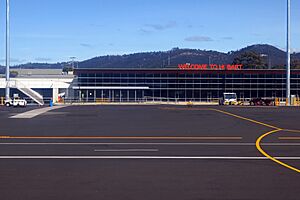
Hobart is served by Hobart Airport. It has flights to major Australian cities like Melbourne, Sydney, and Brisbane. The airport has had big upgrades in recent years. A runway extension was completed, allowing for more international flights.
Seaport
Hobart's main port is managed by TasPorts. It is used for Antarctic operations, cruise ships, and fishing boats. Sullivans Cove has many piers for boats and yachts.
Trains
While freight trains no longer run within Hobart, TasRail still operates a transport hub north of the city.
Hobart once had passenger train services and a tram network. The tram network closed in the early 1960s. Suburban passenger trains stopped in 1974. There has been talk of building a light rail network along old train tracks to help with traffic.
City Services
Learning and Schools
Greater Hobart has many primary, secondary, and college schools. These include public, Catholic, and private schools. The Department for Education, Children and Young People runs government schools.
Hobart is home to the main campus of the University of Tasmania. It has several colleges for students to live in. The university also has sites in the city centre for medical science and arts.
TasTAFE has seven campuses in Greater Hobart. They offer vocational education and training.
Hospitals and Health
The Royal Hobart Hospital (RHH) is the main public hospital in Tasmania. It is in central Hobart. It is also a teaching hospital for the University of Tasmania. There are also several ambulance stations in the area.
The Hobart Private Hospital is a private hospital next to the RHH. The Calvary Hospital is another private hospital in Lenah Valley.
Famous People
- Alanna Smith, basketball player for the Minnesota Lynx
- Nyadiew Puoch, basketball player for the Atlanta Dream
- Errol Flynn (1909–1959), Hollywood film actor
- Regina Bird, reality television personality
- Alec Campbell (1899–2002), last Australian survivor of the Gallipoli campaign
- Queen Mary of Denmark (1972–)
Sister Cities
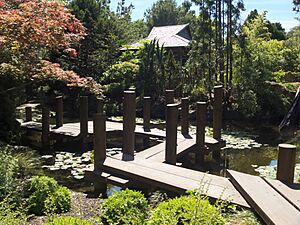
 Yaizu, Shizuoka Prefecture, Japan (1977)
Yaizu, Shizuoka Prefecture, Japan (1977) L'Aquila, Abruzzo, Italy (1980)
L'Aquila, Abruzzo, Italy (1980) Valdivia, Los Ríos, Chile (1998)
Valdivia, Los Ríos, Chile (1998) Xi'an, Shaanxi, China (2015)
Xi'an, Shaanxi, China (2015) Fuzhou, Fujian, China (2017)
Fuzhou, Fujian, China (2017) Barile, Basilicata, Italy (2009)
Barile, Basilicata, Italy (2009)
See also
 In Spanish: Hobart para niños
In Spanish: Hobart para niños
- Hobart City Centre
- 2018 Hobart floods


